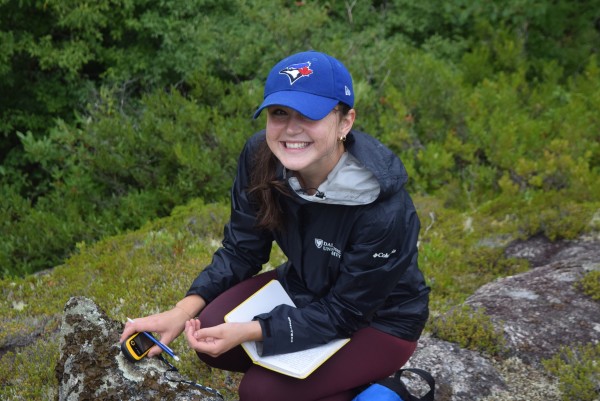
Project: Phenology, distribution, and abundance insect prey in the Williams Lake Backlands: implications for endangered insectivores
Project description:
Siobhan will conduct field work in the Williams Lake Backlands, a unique urban wilderness near Halifax. The area comprises many sensitive habitats supporting several Species At Risk, but experiences increasing pressure from an expanding recreational trail network and residential housing development. The field study will be done collaboratively with local citizen scientists and a corresponding summer research project on the Common Nighthawk, a migratory bird Species At Risk. It will take place from mid-May to late August 2024 and will focus on understanding the seasonal emergence of insects, their distribution and abundance in relation to major habitats and their predators. She will quantify insect population abundance, composition and diversity throughout the spring and summer using repeated light trap sampling and will relate the observed patterns to the distribution of wetlands and other key habitats. In collaboration with the corresponding honours project on the Common Nighthawk, the student will draw conclusions on the prey use and feeding ecology of that species. In the 2024-2025 academic year, Siobhan will use the data she collected for her honours project in Conservation Biology. Her thesis will estimate the size and spatial distribution of the insect prey population in the Backlands, use GIS mapping to evaluate the relative importance of different habitats, and identify areas most crucial to feed and maintain the local Nighthawk breeding population, as well as other insectivores.

Project: Spatial ecology and conservation of Common Nighthawks
Project description:
The Biology honours student will conduct field work in the Williams Lake Backlands, a unique urban wilderness near Halifax. The Backlands, which comprises many sensitive habitats and supports several Species At Risk, is under increasing pressure from an expanding recreational trail network and residential housing development. The field study will take place from mid-May to late August 2024 and will focus on the Common Nighthawk, a migratory bird Species At Risk. This aerial insectivore has been observed to nest on the barrens and capture flying insects by foraging over lakes and wetlands on the Backlands. The student will quantify Nighthawk population size and its movements and habitat use through observational field surveys, GIS mapping, deployment of Autonomous Recording Units, and analysis of the recordings. In the 2024-2025 academic year, the student will use the data she collected for her honours project in Conservation Biology. Her thesis will likely document the size and spatial distribution of the Nighthawk population in the Backlands, use GIS to map and evaluate the relative importance of the different areas and habitats for the Nighthawks, and identify areas most crucial to conserve to maintain the local Nighthawk breeding population.

Project: Identifying shark nursery areas in the Panamanian Pacific Ocean
Project description:
Sharks belong to an ancient group of fish whose skeleton is cartilaginous rather than bony, like other vertebrates. They have been on the planet for more than 400 million years, surviving mass extinctions but despite their evolutionary adaptive capacities, their populations have been greatly reduced caused by anthropogenic activities, including overfishing and habitat loss. Part of the solutions to this conservation problem is area-based protection of critical habitats, such as nursery areas where sharks give birth and spend the first stages of their life. The goal of this thesis is a comprehensive study of shark nursery areas in the Panamanian Pacific Ocean. Chapter 1 will compile information about all shark nursery areas that have been globally described in the literature to create a model that predicts the location of these sites for different species from key environmental characteristics. Chapter 2 will focus on interviews applied to different stakeholder groups involved with sharks, focusing on fishing communities, scientific and government institutions, attempting to locate all sites where neonatal or juvenile sharks are fished. Chapter 3 will use data on protected area locations, fishing effort, and shark migratory routes to further explore where sharks might be most exposed to threats as they migrate towards and reside in nursery areas. This is expected to reveal where sharks intercept major fishing areas and newly expanded marine protected area networks. The fourth chapter will overlay information from the previous chapters to determine sites with a high possibility of new nursery areas to be then sampled and analyzed using a combination of field survey methods. To conclude, this thesis will generate comprehensive information on essential habitats for sharks in Panama, to inform and strengthen existing management and conservation efforts.

Project: A world of Forms: Marine community change and associated ecosystem consequences using global trawl surveys
Project description:
In collaboration with researchers at Dalhousie University, Department of Fisheries & Oceans Canada, and Woods Hole Oceanographic Institute, masters student Brian Schatteman will be completing a thesis on benthic marine community dynamics of highly fished continental shelves around the world, beginning on the Scotian Shelf. Taking advantage of the compiled FISHGLOB global trawl survey dataset, he will attempt to append the publicly available dataset with missing survey region DFO Newfoundland and develop methods for analyzing temporal trends in community composition, stability, biodiversity, ecosystem function, and life history and associating them with climate and harvesting pressures. Focusing on arctic, subarctic, and northern temperate ecosystems witnessing regime shifts from cold adapted communities to warmer adapted assemblages, he would like to identify subregions within the global FISHGLOB dataset exhibiting comparatively high resistance/resilience to community change and investigate mechanisms for this stability. Ideally, this will inform managing and harvesting practices in these northern ecosystems with potential takeaways for southern hemisphere analogs like coastal Tasmania.


